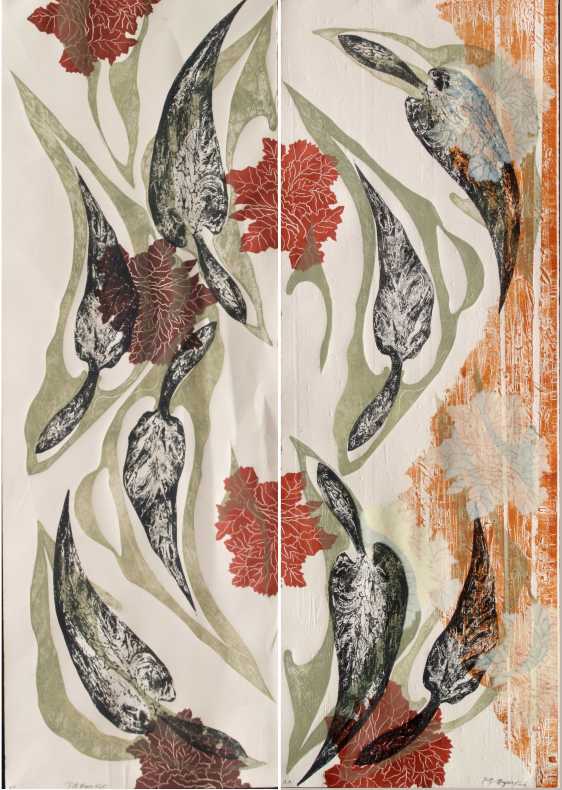LINOLEUM BLOCK PRINTING
A linoleum plate is a wonderful material for artwork:
In the first place, linoleum enables me the carving and cutting of lines and forms on the surface of the plate, in order to create a deep guiding line.
Next, I role paint over the relief, placing a sheet of paper on it and printing my work of art. This is done with a hard roller, a baren or a wooden spoon using manual pressure or pressure of a printing press roller.
The final outcome is a mirror image. The process is simple and needs little preparation.
I love the unbearable ease at which a knife or a chisel glides through the linoleum, soft and smooth: It surrenders to every move of the elbow, advances, stops, changes direction, moves again in a different angle and then is pushed forward by the skilled hands of the artist. Every time the printed paper is revealed from under the press roller, a new surprise awaits me and I stand flabbergasted and thrilled; I discover the accuracy of the outlines, the richness of the textures, the subtly rugged appearance, the shiny colors illuminating one through the other, the strong contrasts and protruding images. Thus I became an "addict" of the printing process.
I usually tend to use several linoleum plates simultaneously: I prepare in advance an exact registration between them. Each plate has its own color, and each is printed on the same paper, one over the other.
On the other hand, I prefer to use Pablo Picasso's work method, called "progressive destruction", using one plate only. This is a process of subtracting from a single plate printing - each time with another color - on the same paper: The plate is slowly destroyed and this is why the number of prints has to be determined beforehand.
Cutting linoleum enables endless possibilities of expression for the arsenal of ideas and inspiration of the artist.
My works in this exhibition were made by combining two techniques:
A. The preparation of a carved and punctured stencil from a linoleum plate, the printing, and repeating it in various directions, and in a variety of ways.
B. The preparation of an adhesive print - a "collagraph" - which acts as a background rich in textures. The stencils have been carved manually using cutting knives or with the aid of a Pyrograph.
The images depicted in "Flora", are part of a larger work called "Flora and Fauna" and refer to the vegetation of my region: Yet, they are mostly the product of my imagination and their form is simple and iconic.
They create a dialogue amongst themselves and within the space between them, which continues on and on endlessly; much like the images on wallpaper.
Ruth Mayon Kuck
|
|

Ruth Mayon Kuck-From series-Flora and fauna- Linocut
LINOLEUM BLOCKDRUCK
Die Linoleumplatte ist ein wunderbares Material für die Kunstarbeit:
Als Erstes, ermöglicht mir Linoleum das Schnitzen und Schneiden von Linien und Formen auf der Oberfläche der Platte, um tiefe Leitlinien zu schaffen.
Als Zweites, rolle ich Farbe auf das Relief, lege ein Papier drüber und drucke mein Kunstwerk - mit einer harter Walze, Baren oder Holzlöffel, mit Handdruck oder dem Gewicht der Linolwalze einer Druckerpresse. Das Endergebnis ist ein Spiegelbild. Der Prozess ist einfach und benötigt nur wenige Vorbereitungen.
Ich liebe die unendliche Leichtigkeit, mit der man das Messer oder Schnitzinstrument im Linoleum führen kann, weich und glatt: es reagiert auf jede Bewegung des Ellbogens, schreitet vorwärts, hält an, ändert die Richtung, setzt wieder in einem anderen Winkel fort und drängt vorwärts in den geübten Händen des Künstlers.
Jedesmal wenn das fertig gedruckte Papier aus der Druckerpresse hervorscheint, bereitet es mir eine neuerliche Überraschung: ich stehe wortlos und voll Freude davor und bewundere die Schärfe der Linien, die Reichhaltigkeit der Texturen, die zarte Rauheit. Ich entdecke den Glanz der Farben und deren Spiegelungen aufeinander, die starken Kontraste und hervorstehenden Formen: so wurde ich "süchtig" - ein Addict - des Druckprozesses.
Ich benütze meistens einige Linoleumplatten gleichzeitig und bereite im voraus eine genaue Registrierung der Platten vor.
Für jede Platte ist eine eigene Farbe vorgesehen und ich drucke eine Platte nach der anderen auf dasselbe Papier. Andererseits, bevorzuge ich die Arbeitsmethode von Pablo Picasso, genannt "Progressive Zerstörung" ("Progressive Destruction"), wobei nur eine Platte verwendet wird. Hier wird ein Verminderungsprozess auf der Platte angewandt und danach jedesmal mit einer anderen Farbe auf dasselbe Papier gedruckt: Die Platte wird langsam zerstört und daher ist die Anzahl der Drucke von vornherein bestimmt.
Das Schneiden und Schnitzen von Linoleum bietet daher unendliche Möglichkeiten für das Arsenal der Einfälle und Inspiration des Künstlers.
FLORA
Meine Arbeiten, die in dieser Ausstellung gezeigt werden, wurden aus zwei kombiniertenTechniken geschaffen:
a. Die Vorbereitung einer geschnitzten und gestochenen Schablone aus einer Linoleumplatte, Druck in verschiedenen Richtungen, der sich in verschiedenen Variationen wiederholt.
b. Die Vorbereitung eines Klebdruckes - Collagraph - als Hintergrund mit reichhaltiger Textur.
Die Schablonen wurden händisch mit Hilfe von Messern oder einem Pyrographen geschnitzt.
Die gezeigten Imagen in dem Werk "Flora" sind ein Teil einer erweiterten Arbeit namens "Flora und Fauna" und beziehen sich auf die Pflanzen in meiner Umgebung; sie sind jedoch hauptsächlich in meiner Phantasie entstanden und ihre Form ist einfach und ikonisch. Sie bilden einen Dialog sowohl untereinander als auch mit dem Leerraum dazwischen, der, wie Imagen einer Tapete, endlos weiterläuft.
Ruth Mayon Kuck
|